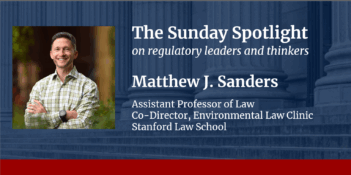
Scholar argues that bill aimed at strengthening safety of chemicals runs afoul of principle of precautionary federalism.
Earlier this week, the Senate approved the Frank R. Lautenberg Chemical Safety for the 21st Century Act, which would amend the Toxic Substances Control Act of 1976 (TSCA). The House approved this bill several weeks ago, so it now heads to the President for his expected signature. Although this legislation would make significant progress toward correcting some of the 1976 law’s greatest flaws, one significant failing remains. By preempting state toxics legislation while the U.S. Environmental Protection Agency (EPA) is merely conducting a safety assessment, rather than waiting to preempt state legislation upon issuance of a final EPA rule, the new law violates an important principle of precautionary federalism.
Scholars and policymakers have long criticized TSCA for its failure to honor a general precautionary principle that tells government that it is better to be safe than sorry when there are potentially significant risks of harm to health, safety, or the environment. Under the precautionary principle, regulators need not wait until there is certainty about these risks to establish regulation. Toxic chemicals—whether in in car seats, clothes, or industrial processes— present precisely the kind of potentially significant risks to health, safety, or the environment for which a precautionary approach makes sense. The precautionary principle shifts regulators’ burden of proving risk and places the burden on industry to prove that chemicals are safe in order to warrant less stringent regulation.
Under TSCA, which the new legislation amends, EPA has borne the burden of demonstrating that a chemical is unsafe before EPA can limit its manufacture, distribution, or use. As a result, EPA has only issued regulations for nine chemicals out of the tens of thousands in today’s marketplace.
Although the precautionary principle usually focuses on whether government should regulate, the principle of precautionary federalism focuses on a different question: who gets to decide whether and how to regulate toxic chemicals—the federal government, the states, or both?
The principle of precautionary federalism has three primary features. First, it embodies a default presumption against federal preemption of state or local law, and in favor of dynamic, overlapping federal and state jurisdiction under conditions of uncertainty about the magnitude of risks to health, safety, or the environment. Second, precautionary federalism requires taking into account tradeoffs across different kinds of risks, and thus recognizes that the default presumption against preemption can be overcome by a showing of the benefits of more uniform legal rules. Third, precautionary federalism recognizes that the initial allocation of overlapping authority may be time-limited, and that a different allocation of regulatory authority between the federal government and the states may become appropriate when uncertainty about the magnitude of risk diminishes.
The principle of precautionary federalism requires that state efforts to regulate toxic chemicals more stringently than the federal government should not be automatically preempted by federal law. At the very least, state efforts to regulate toxic chemicals should not be preempted by federal law when EPA is merely conducting an assessment as to the risks of certain chemicals—that is the point at which uncertainty is at its height. If more information becomes known about the risks of certain chemicals, then an allocation of authority tot he federal government may become appropriate in order to ensure a uniform regulatory approach. Unfortunately, the new amendments to TSCA get the allocation of authority precisely backwards.
TSCA originally preempted certain kinds of state regulation of toxic chemicals, but it contained no limits on state action until EPA had promulgated a final rule once safety testing was completed. Because EPA undertook so few actions to regulate toxic chemicals under the original law’s burdensome requirements, many states stepped in to fill the gaps. In 1986, California adopted Proposition 65, and since then, more than a dozen other states likewise have adopted chemical safety laws.
The new legislation passed this week takes a step in an anti-precautionary direction—at least with respect to the allocation of authority between the federal government and the states. The amendments preserve existing state rules but would generally preempt states from adopting new regulations on the manufacture, processing, distribution, or use of a chemical as of the date that the EPA Administrator “defines the scope of a risk evaluation for a chemical substance”—even before EPA issues a final rule. During this period, when EPA is evaluating the risks of particular chemical, uncertainty is unquestionably at its height. When uncertainty is at its height, the need for precaution is at its height as well. Permitting states to regulate chemicals at that time can effectuate the underlying goals of the precautionary principle, by allowing them to guard against uncertain risks. Although there are some limits on these preemption provisions, including “pauses” that permit states to regulate during a limited time window, and states may continue to require information disclosure about potential risks, it is not clear that these limitations are sufficient to effectuate the goals of a precautionary approach.
Policy experimentation is most needed under conditions of uncertainty. Allowing states to regulate even when EPA is still investigating a chemical’s toxic effects can also limit the risk of interest group capture at any one level of government. Although states may apply for waivers of the preemption provisions under the new law, there is no guarantee that such waivers would be granted.
To be sure, industry tends to prefer uniform rules to promote innovation and to avoid facing potentially conflicting rules. The principle of precautionary federalism recognizes that uniformity may be desirable once better information becomes available. Thus, the initial allocation of authority can and should be revisited when there is greater certainty about risks, and a shift from dynamic, overlapping jurisdictions to a more uniform allocation of authority at the federal level may become appropriate. But the new legislation introduces preemption far too early in the process. A better approach would have been to permit state experimentation and regulation as a matter of course during the risk evaluation period, when uncertainty is at its height. Only once the uncertainty about a chemical’s health effects is reduced should preemption come into play.




